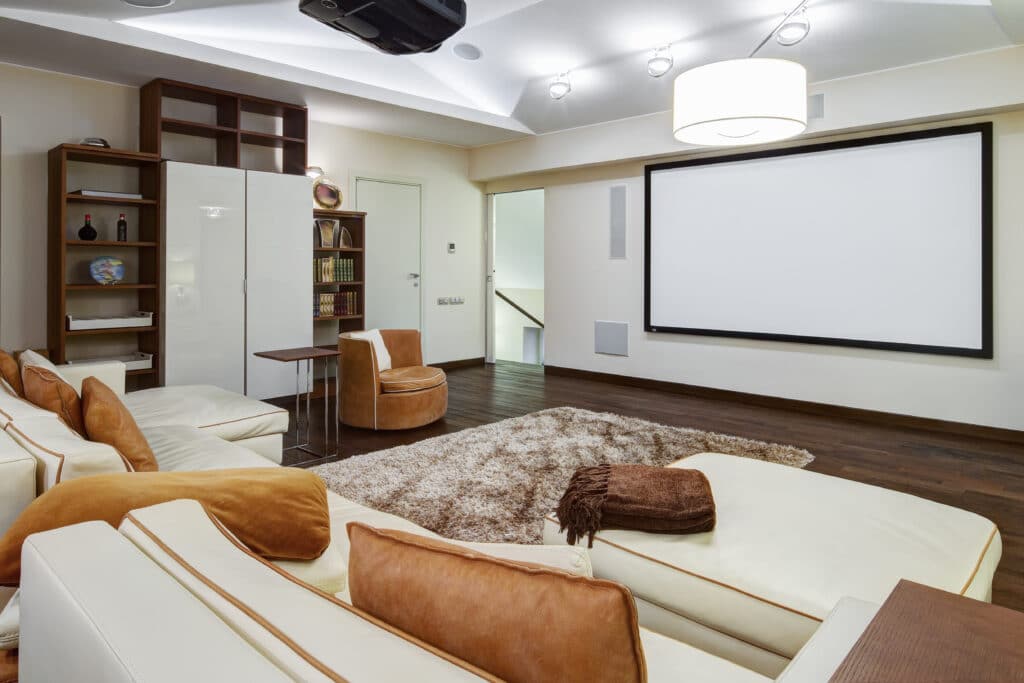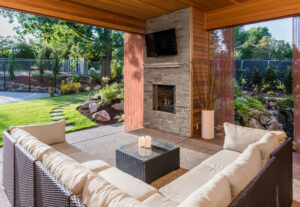A home theater is a luxurious addition to any home. A good home theater can transform an ordinary house into something special. But before you start looking for home theater components for your dream home theater, it’s essential to know all about them. This guide will provide you with crucial information on what makes up a high-end system so that you can shop confidently when the time comes!
Home Theater Components
Building a home theater system involves assembling several key components. At first glance, the process can seem overwhelming, especially when you start digging into the fine details. Between the display, receiver, speakers, media sources, lighting, and other accessories, there’s a lot to consider. Before you dive into shopping or setting anything up, it’s helpful to understand the fundamental components of a home theater and what role each one plays in creating an immersive entertainment experience.
Display
The display is the heart of any home theater system. It’s the primary device responsible for delivering the visual experience and often sets the tone for the rest of the setup. Choosing the right display is crucial because it directly impacts how you enjoy movies, TV shows, video games, and sports. You’ll typically be deciding between two main options: televisions or projectors, each offering unique advantages depending on your space and viewing preferences.
TVs
TVs are the most popular type of display for home theaters. They tend to be more affordable than projectors and are far easier to use on a daily basis. However, they have some limitations, such as difficulty achieving perfect contrast ratios due to screen glare, especially in outdoor settings or well-lit rooms.
When it comes to TVs, there are a few key options: LED, OLED, and 4K.
- LED TVs – LED TVs offer a thin profile and solid picture quality. They are very bright, available at a wide range of price points, and are a great option for many home theater components.
- OLED TVs – Offering perfect black levels and infinite contrast, OLED TVs are the superior choice for home theater systems. They deliver a higher-quality picture than LED TVs, but they do come with a higher price tag.
- 4K TVs – The latest trend in home theater components, 4K TVs provide ultra-high-definition (UHD) resolution, delivering four times the clarity of Full HD sets. These displays offer stunning picture quality and come equipped with smart TV features that easily connect your entertainment center or cable box to your home theater system.
Screen quality is an important feature to consider when choosing the right TV for your setup. It all comes down to your personal needs and finding the right balance between quality and price.
Projectors and Screens
Projectors are an essential component of home theaters when it comes to achieving the best quality. They’re the best choice if you don’t want to deal with interference from ambient light in your home theater room. and don’t want to be limited to screen size, as most TVs don’t go above 70″. Additionally, they offer better contrast ratios since they usually have matte screens that prevent reflections.
Projector setups are comprised of a projector and a screen. The best home theaters use high-quality screens that provide the most accurate color reproduction possible, ensuring perfect picture quality for all types of viewers at any time of day or night.
The screen size should be chosen according to the distance between the viewer and the display. An Ultra-High-Definition projector is an excellent choice if you want a top-quality picture with high resolution. However, they are also more expensive than other types of projectors.
Read More: Projectors vs TV for Home Theater
Receiver
The AV receiver is the critical home theater component you can’t do without if you plan for a home theater system. The receiver processes all audio and visual signals, distributing them throughout your TV room through speakers or other devices. This provides an impressive end-user experience as the multimedia content will be in sync.
Speakers
The speakers are the devices that convert electrical signals into sound, which then transmit through your home theater system via the receiver to provide an immersive experience. There are two basic types of home theater speakers: surround sound and front-facing.
Surround sound speakers are ideal for home theaters. They provide the sensation of movies or games being played in a real-life scenario. Surround sound systems have five main types of speakers:
- Front speaker (left and right)
- Rear left or surround back speaker
- Rear right or surround side speaker
- Center speaker for dialogues in movies
- Subwoofer, which gives you the low bass frequencies.
A front-facing home theater system has only two speakers: the left and right front speakers. They produce high-quality audio through two channels – one for dialogue and another to produce ambient noise. You usually place them on either side of your display or TV set to get a surround sound effect.
In-Wall & In-Ceiling Speakers
Want to hide your speakers? You can install them in the walls or ceiling. In-wall and in-ceiling speaker systems are mostly for home theaters that need high-quality sound but don’t want their equipment on display. These speakers are designed to be installed in a wall or ceiling. So, the only thing you see is their grille.
These speakers differ from floor-standing speakers in that they are not visible because of their built-in speaker mounting brackets. They can be flush mounted to the wall or ceiling, which means you’ll get better sound quality without any obstruction.
Pros/Cons of In-Wall/Ceiling Speakers
There are some significant benefits to using in-wall speakers. They’re hidden, so they don’t take up any space on the floor or shelf. Another benefit is that you can have a more discreet home theater system since it’s not as noticeable if there aren’t many visual distractions around your TV room.
On the other hand, in-wall speakers are more expensive than normal front or surround sound speakers because you need to hire a professional contractor to install them (since they’re for experienced home theater builders). You also can’t move these speakers around if you decide your TV room layout needs an upgrade later on down the line.
Overall, speakers and subs can be invisible if you get in-ceiling or wall speakers. This is the best way to make your home theater system truly disappear into its surroundings, making it a more immersive experience.
Lighting and Shading
Automated lighting and shading are great additions to improve your home theater system. These features enhance the overall atmosphere of your media room, making it feel more luxurious and immersive.
Lighting systems offer customizable ambient lighting during your movie nights, while automated shading gives you control over natural light levels. Together, they create the perfect darkened, cinema-like environment, allowing you to relax and fully immerse yourself in the movie. Plus, with the ability to pause and adjust the lights as needed, you can tailor the experience to fit any mood or viewing preference.
Read More: Home Theater Automation 101
Media Source Components
This category of home theater components includes secondary devices used to provide multimedia content. This can include Blu-Ray players, media servers, gaming consoles, DVRs and more.
These devices are responsible for playing back DVDs, providing access to online media libraries or other streaming sources, like Netflix, Hulu, or Amazon Prime.
Home Theater Furniture
Home theater furniture is a category of home theater components that can take an ordinary home media room into a luxury home theater.
Recliners, sofas, and other comfortable seating can help your family and guests relax while binging the new season of your favorite show. Home theater seating provides the ultimate comfort while you enjoy your favorite multimedia content on your home theater display.
Choosing your home theater furniture should be done according to the size and shape of your home theater room. In addition, you should also consider other factors such as comfort and aesthetics before making a final purchase decision.
Surge Protector
Finally, a surge protector is an essential home theater component that you need to include in your system. The job of the surge protector is to protect all components from power surges, which can cause irreparable damage to your home theater system.
In addition, the surge protector also contains a long list of safety features that prevent electrical fires from occurring in your media room without any warning signs.
Bring Your Dream Home Movie Room to Reality with the AIS Team
We are here to provide you with the best possible solutions when it comes to setting up a fully functional media room in your home. Our team will help you choose all the essential components that go into a home theater system so that you can enjoy state-of-the-art entertainment at any time. We also are able to enhance the acoustics of home theater rooms.
Furthermore, we collaborate with interior designers and contractors to ensure that each unique design is flawless. This is the perfect way to get the home theater of your dreams without having to do any of the work yourself.
The Advanced Integrated Systems (AIS) team has years of expertise in home theater installation and design services in Northern Utah. We know how to bring your dream home movie room to reality, which is why so many homeowners rely on us for high-quality service at an affordable price. Stop dreaming and start planning your home theater today with AIS.




